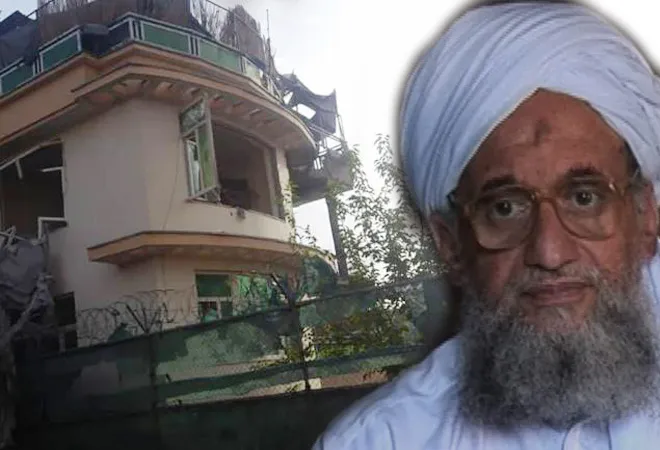
On 1 August 2022, the United States (US) President Joe Biden announced the killing of the al-Qaeda leader Ayman al-Zawahiri in a drone strike executed by the Central Intelligence Agency (CIA) in Kabul. The strike demonstrated the ‘over the horizon’ (OTH) capability, proclaimed by the US national security establishment, since the withdrawal of the American military forces from Afghanistan in 2021. This article explains the working of the OTH capability and examines the significant challenges that this counterterrorism (CT) measure faces in its application.
Speaking on 8 July 2021, President Biden, while dispelling concerns over the US’ ability to deter al-Qaeda and other terrorist groups operating in Afghanistan after the withdrawal, remarked, “We are developing a counter-terrorism over-the-horizon capability that will allow us to keep our eyes firmly fixed on any direct threats to the United States in the region, and act quickly and decisively if needed.” Initially, it was speculated that this entailed providing air support to the Afghan security forces to repel Taliban aggression and go after the cadres of al-Qaeda and other terrorist groups.
However, as the Afghan resistance wilted in the face of the advancing Taliban forces, American officials redefined the OTH approach to imply stand-alone drone strikes without on-the-ground support. Weeks after the Taliban takeover of Kabul, President Biden spelt out the OTH capability to “strike terrorists and targets without American boots on the ground—or very few, if needed.”
The strike demonstrated the ‘over the horizon’ (OTH) capability, proclaimed by the US national security establishment, since the withdrawal of the American military forces from Afghanistan in 2021.
The US has utilised the OTH capability for years to target the al-Qaeda leadership in other theatres like Somalia, Syria, Libya, Iraq, and Yemen. For instance, in March 2017, the CIA killed the deputy leader of al-Qaeda, Abu al-Khayr al-Masri in an airstrike in Idlib province in Syria.
The key components of the OTH capability are:
- Drones or unmanned aerial vehicles: The US has generally deployed the MQ-1 Predator (range: 770 miles) and its much more powerful successor, MQ-9 Reaper (range: 1150 miles) armed drones for the strikes. These can be launched from bases or ships.
- Missiles: The US military has used the AGM-114 Hellfire family of missiles for the strikes. This includes the Hellfire II missile, a precision strike, semi-active laser-guided missile. Media reports also note the development of a newer version of the Hellfire missile, named R9X, which has no explosives but ejects six large blades as it nears the target. Reportedly, this missile was used in targeting Zawahiri and earlier al-Masri in 2017.
- Sensors, radars, and tracking devices: The US uses ground-based (on the ship or land, or tethered aerostats), airborne (fixed-wing manned or unmanned aircraft), and space satellites.
- Intelligence collection: This is done through technical, electronic, open source, and human sources.
In operating this OTH capability in Afghanistan, the US faces two unique challenges: Airspace access and on-the-ground intelligence collection.
Airspace Access
The US OTH capability to strike targets in Afghanistan is majorly constrained by issues related to access to the Afghan airspace since it has no military bases in any of Afghanistan’s neighbours.
For years, the US operated its drones from airbases in Pakistan to strike the al-Qaeda and Taliban commanders, who had taken shelter in Khyber Pakhtunkhwa province. However, as bilateral ties with Pakistan deteriorated, the US-Pakistan CT cooperation too plummeted. Former Pakistani Prime Minister Imran Khan’s government had asserted that it would never provide Pakistani bases to the US. Moreover, access to two other neighbours—China and Iran—is simply ruled out.
Out of Afghanistan’s immediate neighbourhood, the US has several bases in the Gulf, the largest one being the Al Udeid airbase in Qatar, where the US Air Force maintains a significant number of assets, including armed drones.
The US had access to bases in Uzbekistan and Kyrgyzstan in the early 2000s. However, Russia and China, fearful of growing American influence in Central Asia, pressured the two countries to rescind this access. At the time of its Afghanistan withdrawal, Washington explored reviving this access to reposition some of its military assets from Afghanistan, but it did not materialise.
Out of Afghanistan’s immediate neighbourhood, the US has several bases in the Gulf, the largest one being the Al Udeid airbase in Qatar, where the US Air Force maintains a significant number of assets, including armed drones. In the operation targeting Zawahiri, it is speculated that the US used either a base inside Pakistan or a US military base in the Gulf, using Pakistani airspace to reach Kabul.
Drones like Reaper can fly a long distance to execute such strikes, spending about two-thirds of their mission flying in and out of Afghanistan. Some experts have, however, argued that this long distance could hamper the effectiveness of the operation, which requires threat identification and target engagement. To overcome this ‘tyranny of distance’, there also have been suggestions to use US Navy aircraft carriers stationed in the Indian Ocean to launch drones to Afghanistan.
Intelligence Collection
The US has advanced its precision-strike capabilities, especially in developing the R9X missile to avoid civilian casualties. However, the success of the drone strikes is also contingent upon identifying the right target—an outcome of intelligence collection primarily through human sources and its subsequent analysis. This human intelligence, or HUMINT, is crucial in enabling drones and other aerial platforms to gather further intelligence through technical and electronic sources. In addition, it provides information for building “patterns of life” necessary in identifying high-value targets like Zawahiri.
Post-withdrawal, such intelligence gathering on potential terrorist threats has become difficult for the US due to minimal or zero American presence on the ground, the absence of credible local partners, and a hostile regime in power. Moreover, in the run-up to the withdrawal, military officials acknowledged that the US had lost 90 percent of its drone-based intelligence collection capabilities in Afghanistan.
The success of the drone strikes is also contingent upon identifying the right target—an outcome of intelligence collection primarily through human sources and its subsequent analysis.
In the absence of reliable intelligence, the potential for cases of mistaken identity increases exponentially as decision-makers often erroneously draw conclusions on the gravity and imminence of the threat and the identity of targets. The risks arising from faulty intelligence were gravely demonstrated on 29 August 2021, when the US military struck an Afghan aid worker in Kabul, mistaking him for an Islamic State operative. The strike killed ten civilians. So, even the precision-strike capability cannot resolve the problem of mistaken identity arising from inaccurate intelligence.
Too much reliance on OTH?
The frequent targeting of the terrorist leaders by the US military and the CIA has spawned a fundamental question—whether the OTH CT capability can genuinely ensure the decimation of the terrorist movement. Those who note the over-dependence of the US on OTH capability and oppose making it a key dimension of the CT strategy contend that mere drone strikes against the high-value targets will not yield the ultimate desired result, i.e., a decisive weakening of al-Qaeda. They cite the historical trend where the US military eliminated key al-Qaeda leaders regularly and projected the defeat for the group. And yet, al-Qaeda has continued to thrive, albeit with restricted geographical coverage and curtailed activities.
While this may be a legitimate query, it is also true that after conducting one of the longest overseas operations, US policymakers are now averse to the idea of keeping soldiers on the ground to fight the terrorist operatives and taking the risk of American casualties. Hence, the OTH CT capability will remain relevant and a preferred approach for them, particularly as advances in automation technology augment the drone capabilities and make it less risky.
The views expressed above belong to the author(s). ORF research and analyses now available on Telegram! Click here to access our curated content — blogs, longforms and interviews.




 PREV
PREV


